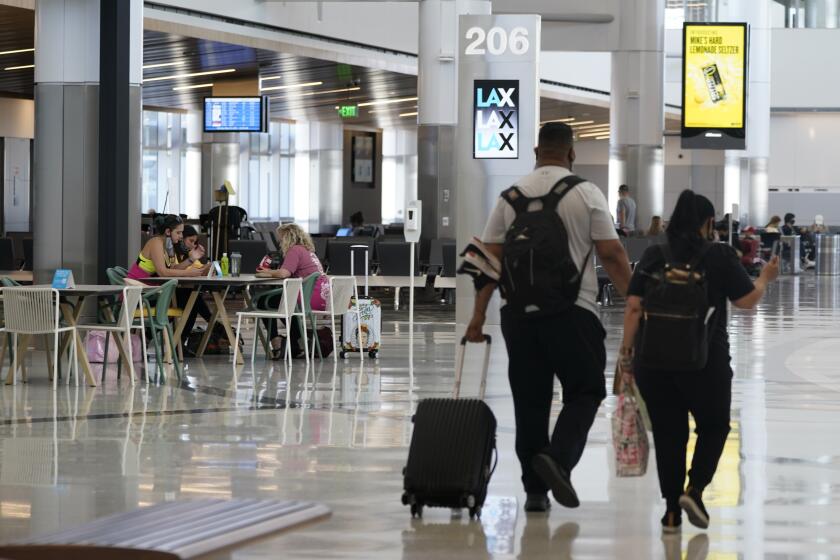Report Backs $445-Million Burbank-L.A. Light Rail Link : Transportation: Proponents say the study should persuade the county to build the line before the end of the century. It would use existing tracks.
- Share via
Connecting Burbank, Glendale and downtown Los Angeles with a light rail line would have some negative effects--such as the demolition of a historic building--but would be “environmentally superior” to having no line at all, according to a summary of a report released Wednesday.
Proponents of the proposed 11.9-mile line said the document gives generally positive marks to the project and will help persuade county transportation planners to build the line before the end of this century.
“I think the EIR substantiates what we’ve been saying all along and that is that this line is really positive for the entire system,” said Glendale Assistant City Manager Steven Adams, who is part of a coalition promoting the line. The coalition includes business leaders and city officials from Burbank, Glendale and Pasadena.
The rail line, which would begin at the Burbank Airport and run south through Glendale to Union Station, is one of six light rail projects competing for funding priority under Los Angeles County’s 30-year Integrated Transportation Plan. If the Los Angeles County Transportation Commission gives the line priority over other projects, it could be constructed before the end of the century.
The $445-million light rail line would use existing railroad tracks and include 10 stops. It would meet up with the Pasadena-to-Los Angeles line near the interchange of the Golden State Freeway and the Pasadena Freeway. Constructing a connector to transfer to the Pasadena line would cost an additional $55 million.
The Burbank-Glendale-Los Angeles line would serve the Burbank City Centre, Burbank Media District, Glendale Grand Central Industrial Business Park, Glendale Central Business District, Los Angeles Zoo and Gene Autry Western Heritage Museum.
The summary report, drafted by Gruen Associates of Los Angeles, estimates that the line would serve an average of 33,000 passengers a day. It could carry a passenger from Burbank Airport to Union Station in about 23 minutes.
The full draft environmental report is scheduled to be released next week after it is approved by the Transportation Commission.
High on the list of significant “unavoidable adverse impacts” of the project, according to the summary report, would be the need to purchase and remove 14 businesses and public facilities along the route--including the old City Jail building near the Los Angeles River, south of the Pasadena Freeway. Businesses employing 143 people would be displaced, according to the report.
To compensate, Gruen Associates suggested paying the relocation costs of displaced businesses and exploring joint development projects so that some businesses can remain in the area.
The potential demolition of the City Jail building, which is eligible to be designated a local landmark, “constitutes a significant adverse impact to local historical resources” according to the report.
Adams said he is not sure whether the historical value of the City Jail building is sufficient to block the line’s construction. He said that although the building has some historical significance, it is not on the state registry of historic landmarks.
Project manager Peter De Haan said final design studies for the line may show a way to work around the building without relocating or demolishing it.
The report also notes that vehicle traffic around the rail stops would create air pollution. However, the report also says that the light rail line would bring about a net improvement in regional air quality because motorists would leave their cars behind to ride it.
Adams said the city of Glendale has offered to pay 20% of the total cost of the section that travels through Glendale and has already begun to build one of the stops in that city.
To speed the project along, the cities of Burbank and Glendale also helped pay for the environmental report.
Adams said the line is much less expensive to build than most of the other projects under consideration by the Transportation Commission. According to a cost analysis by county transportation planners, construction of the Burbank-Glendale-Los Angeles line would cost $35.5 million per mile. The cost of other proposed light rail lines ranges from $40.3 million per mile to as much as $319.4 million per mile.
De Haan said the commission is expected to decide by November which project will get the priority funding.
So far, only one of the other light rail projects competing for the funding has come as far in the planning process as the Burbank-Glendale-Los Angeles line.
De Haan said that may help. “One criteria may be project readiness,” he said.
More to Read
Sign up for Essential California
The most important California stories and recommendations in your inbox every morning.
You may occasionally receive promotional content from the Los Angeles Times.











